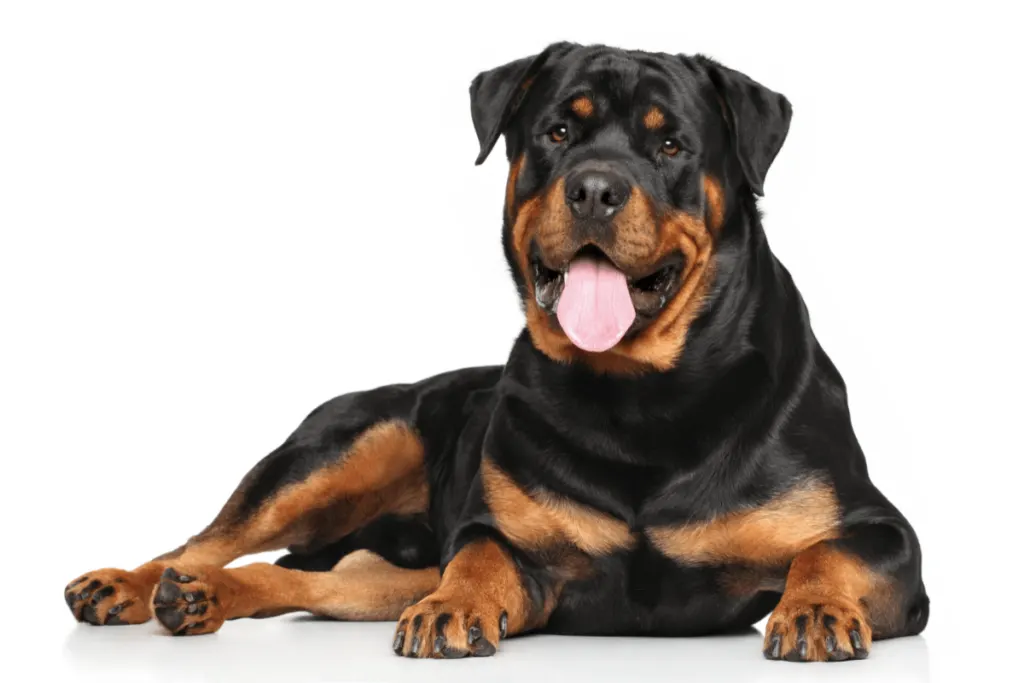
Rottweilers are an internationally recognized breed of dogs. This means that something called a breed standard exists for them.
A breed standard describes what a purebred specimen of that breed should look like.
Not all Rottweilers look the same, but all well-bred and purebred individuals should conform to the established breed standard. You can get a very traditional-looking Rottweiler who has a different breed in its ancestry, and you can get a purebred Rottweiler that does not meet the standard.
This article discusses all the ways in which you can recognize a purebred Rottweiler.
We base this primarily on the American Kennel Club’s Rottweiler breed standard, but we also include any differences or additional features as recorded by the Kennel Club of the United Kingdom.
Click Here to Jump to a Section
How Do You Know if Your Rottweiler Is Purebred?
There is no Rottweiler gene that you can perform a DNA test to see if your Rottweiler is a purebred specimen, but below are some tips to help you know if your Rottweiler is real or purebred.
Buy From a Registered Rottweiler Breeder
The most reliable way that you can ensure that your Rottweiler is a purebred Rottweiler is to buy one from a registered breeder.
These breeders have to be assessed by the governing body of the organization with which they would like to become registered.
Additionally, each dog that they breed with has to be evaluated and have traceable ancestry to ensure that there are no mixed breed dogs hiding in their family tree before they can be registered.
A non-purebred Rottweiler or even a Rottweiler with any one of a number of specified flaws will be disqualified and cannot be registered as a purebred Rottweiler.
Compare the Rottweiler to the Breed Standard
Suppose your Rottweiler matches the detailed descriptions provided in the breed standards.
In that case, the likelihood of the Rottweiler being a purebred is much greater than if they have an obvious deviation from the standard.
Bad Form Does Not Mean Mixed Genes
However, you should keep in mind that a purebred Rottweiler can carry bad genes that make it deviate too much from the standard that it can never be registered with a governing body like the AKC or the Kennel Club of the UK.
Mixed Genes Do Not Mean Bad Form
A Rottweiler with one Rottweiler parent and one parent of a different breed is more likely to have the appearance of a mixed breed dog.
But suppose the different breed was introduced further back in the genetic line, and only Rottweilers have subsequently been bred to the Rottweiler cross.
In that case, you might have a hard time picking up any physical feature that tells you your Rottweiler is not a purebreed.
As mentioned previously, the breed standard descriptions are what we will be discussing in this article, but first, there is one last tip that is important for you to know.
Look at the Rottweiler’s Parents
Sometimes, it is difficult to tell if puppies are purebred because the breed standard applies to adult dogs, not to a four-month-old puppy.
So, if you are purchasing from a breeder who is not registered, then make sure you ask to see the parents.
If both the parents match the breed standard, then your Rottweiler is more likely to be a purebred Rottweiler.
However, if the breeder refuses to show you one of the parents, then run for the hills because that is a red flag sign in terms of breeding quality.
AKC’s General Appearance Description of a Rottweiler
The following is a quote from the AKC’s breed standard:
“The ideal Rottweiler is a medium large, robust and powerful dog, black with clearly defined rust markings. His compact and substantial build denotes great strength, agility and endurance. Dogs are characteristically more massive throughout with larger frame and heavier bone than bitches. Bitches are distinctly feminine, but without weakness of substance or structure.”
How Big Is a Purebred Rottweiler?
Sexual dimorphism is a phrase used to describe the physical differences (apart from the obvious external reproductive organs) that exist between a male and a female of a certain species.
Most dog breeds display sexual dimorphism, but it is limited to differences in size. So, male Rottweilers are larger than female Rottweilers.
Purebred male Rottweilers should stand 24 to 27 inches (63 to 69 cm) tall.
The weight range of 95 to 135 (43 to 61 kg) pounds refers to a healthy male Rottweiler who is neither overweight nor underweight.
Purebred female Rottweilers are slightly shorter, with an average height range between 22 and 25 inches (58 to 64 cm).
Additionally, they are lighter than the males, weighing between 80 and 100 pounds (36 and 45 kg) when in good health and condition.
What Are the Correct Proportions of a Purebred Rottweiler?
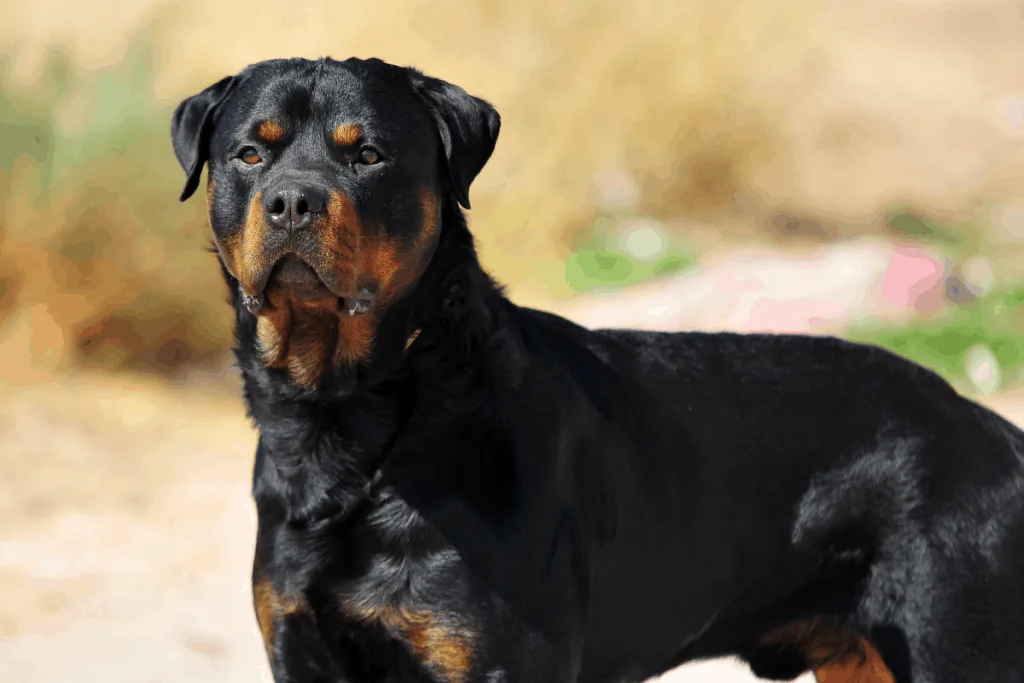
If you were to measure a purebred Rottweiler, you should find that they are slightly shorter than they are long (the ideal ratio of height to length is 9:10).
The length is measured from the Rottweiler’s prosternum, which is the forwardmost part of the chest, to the rearmost part of the dog’s rump.
The height is measured at the withers, which is the height point of the Rottweiler’s back, in line with the shoulders.
The breed standard even specifies the depth of a purebred Rottweiler’s chest. It should be 50% of the dog’s height.
You can have a Rottweiler with the foregoing proportions, but if they do not have the muscle mass to support this frame, then they may not be a purebred Rottweiler.
You need to bear in mind the age and condition of the Rottweiler in this regard.
A young Rottweiler can be lanky, and a malnourished Rottweiler will be thin. However, if a fully grown, healthy Rottweiler is lean or rangy, then they are probably not purebred.
The Head of a Purebred Rottweiler
A purebred Rottweiler’s head should be neither elongated, like that of a Greyhound, nor squashed, like that of a Pug.
The head should be broad between the ears, with a moderately arched forehead (neither flat like that of a Dalmatian, nor domed like that of a Cocker Spaniel), and a well-defined “stop”.
The “stop” is the part of the dog’s head between the eyes; it is the junction between the forehead and the muzzle.
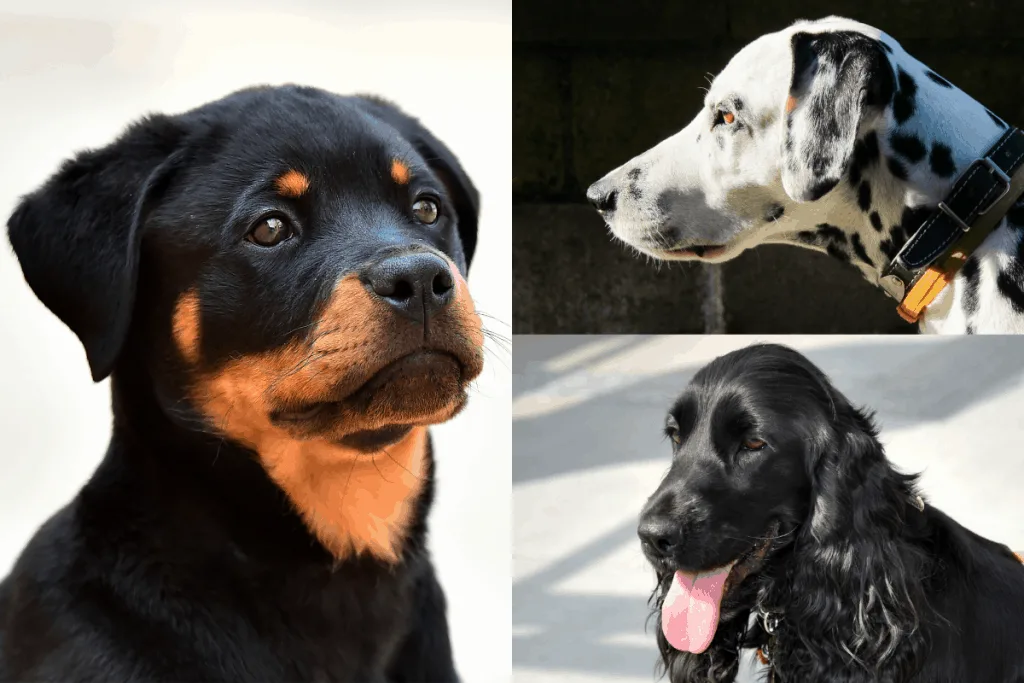
A Purebred Rottweiler’s Muzzle
A purebred Rottweiler’s muzzle (sometimes called “snout”) should have enough tapering towards the nose to be noticeable without creating a pointed end.
The muzzle should still be square in shape and broad, but never as wide as their head
The muzzle bridge should be flat and straight, and the nose should be oval-shaped (as opposed to round) and black.
Any pink or brown markings on the Rottweiler’s nose could be a sign that it is not a purebred.
A Rottweiler should not even have a hint of an underbite like you see in Bull Dogs and the like.
A Rottweiler with an underbite is either not a purebred Rottweiler, or it has a genetic mutation or medical condition that caused the misalignment of the jaws.
A Purebred Rottweiler’s Lips and Mouth
A purebred Rottweiler’s lips are always black, and the pigment inside the mouth should also be dark.
Therefore, pink spots or no dark pigment at all can indicate that the Rottweiler is not a purebreed.
The lips should close at the corners and should not hang below the lower jaw in any significant way. An incredibly jowly Rottweiler is unlikely to be a purebred Rottweiler.
A Purebred Rottweiler’s Eyes
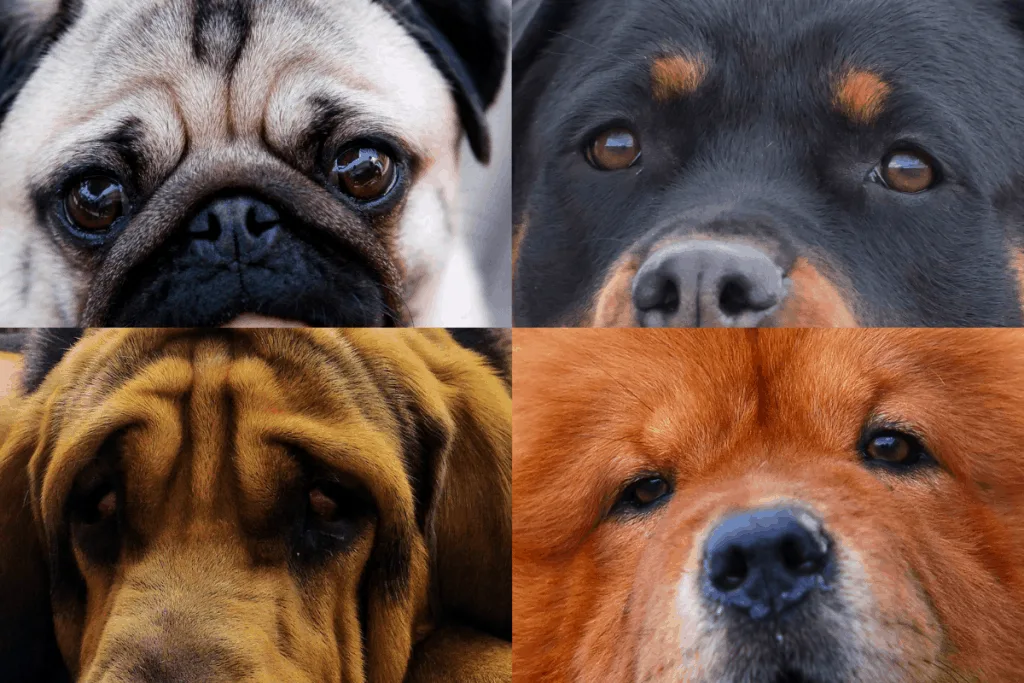
A purebred Rottweiler will have medium-sized eyes. The eyes should be almond-shaped and neither protruding, like those of a Pug, nor deep-set, like those of a Chow Chow.
The eyelids of a purebred Rottweiler should be tight, i.e., they should not droop like a Bloodhound’s eyes, and the rims should not be hairless.
A purebred Rottweiler’s eyes will always be a shade of dark brown. Yellow eyes can appear in a purebred Rottweiler, but that individual dog can never be registered.
However, if the Rottweiler has blue eyes, green eyes, or two different colored eyes, then the chances are very high that they are not a purebred Rottweiler.
A Purebred Rottweiler’s Ears
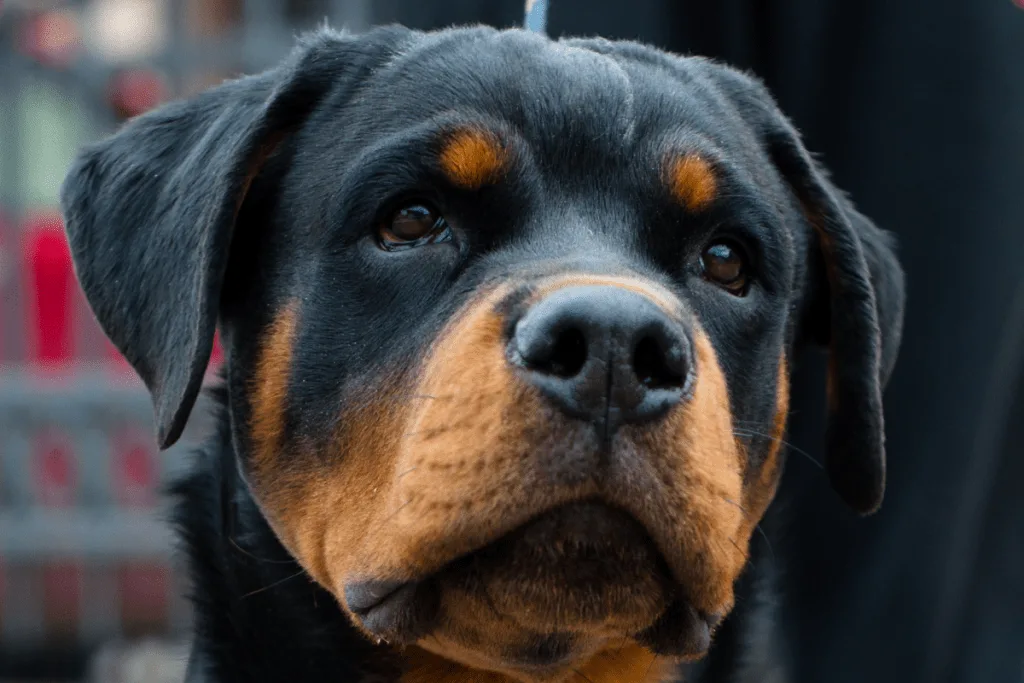
The ears of a purebred Rottweiler should be medium-sized, although they may look slightly too small for the Rottweiler’s head.
The ears should be set wide apart but definitely begin on top of the head (as opposed to the side of the head, like most Spaniels).
A Rottweiler’s ears should be in the shape of a triangle and hang down, with the bottom edge sitting at mid-cheek length.
A purebred Rottweiler’s ears will never stand up (unless they are clipped, but ear-clipping is not acceptable for a Rottweiler). However, the ears can be pulled up on the head when the Rottweiler is alert.
Only when the Rottweiler has pulled its ears up should there be any wrinkling on the forehead.
The Neck and Body of a Purebred Rottweiler
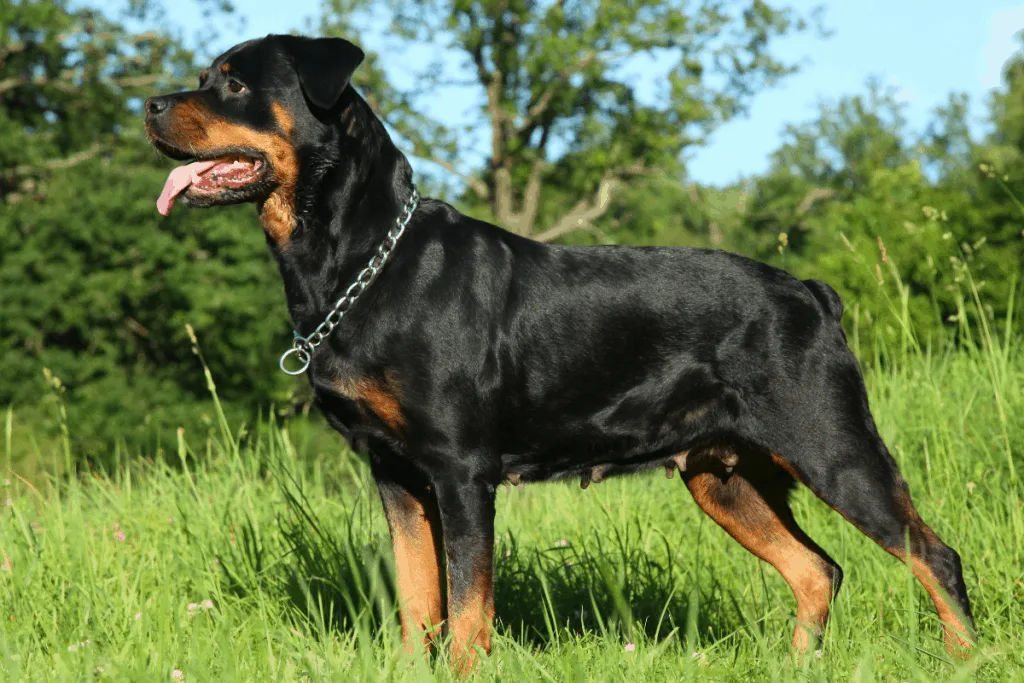
A purebred Rottweiler’s neck should be of medium length, slightly arched, and very muscular. In addition, there should be no “throatiness”, which means the skin should fit tightly over the neck and not form a fold in the front by the chest.
A very overweight Rottweiler might develop a fatty pad at the front of its neck, even if they are a purebreed.
The back of a purebred Rottweiler should not be overly long (remember the proportions we laid out earlier in the article), but it should be straight from withers to croup, which is the rump area just before the tail set.
A slight arch down from the croup to the tail set should be visible.
The underline of the Rottweiler should slope gently upward from chest to rear.
What Should a Purebred Rottweiler’s Tail Look Like?
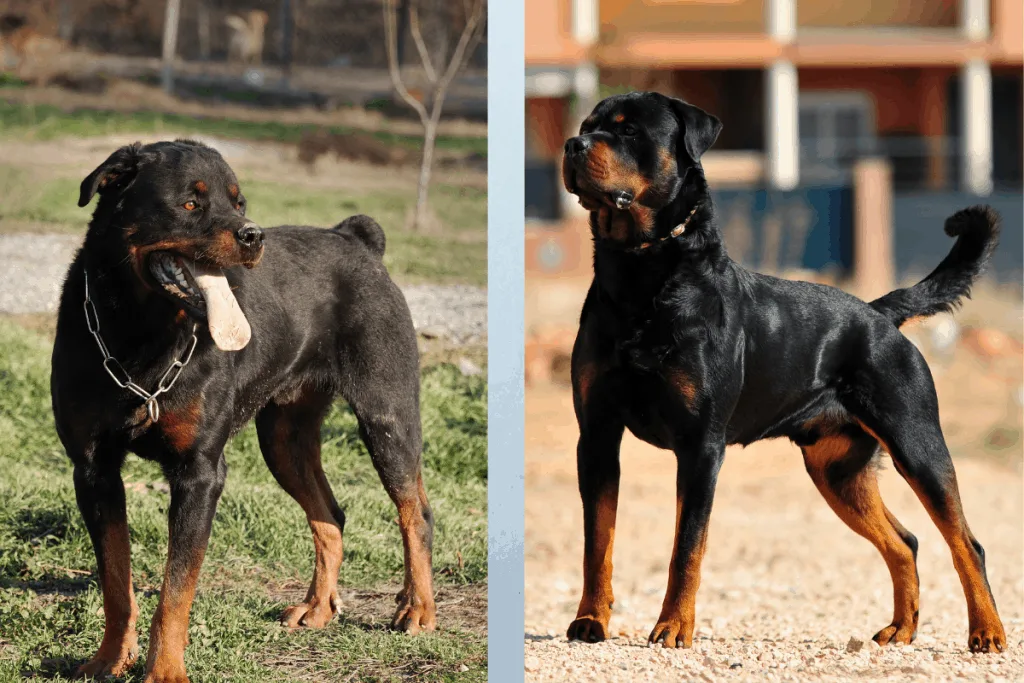
Using a Rottweiler’s tail as a determiner of purebred status is tricky because of the common practice of docking the tail after the first or second vertebrae. So, this practice really does not leave any tail to examine.
However, if your Rottweiler still has a tail, it should be an extension of the topline (set neither too high nor too low on the body).
Additionally, while the tail should not be feathered, it is still covered in the dense fur of a Rottweiler, so it does not look sleek like that of a German Shorthaired Pointer.
The Forequarters of a Purebred Rottweiler
The shoulder blade and upper foreleg bone of a purebred Rottweiler should both be long and of similar lengths, and the distance between the withers and the elbows should directly match the distance of the elbow to the floor.
A purebred Rottweiler’s forelegs should be set under their body but not close together.
A Purebred Rottweiler’s Front Feet
The pastern, which is the portion of the foot that extends between the pad and the dewclaw, should be very upright—almost perpendicular to the ground.
The feet of the front legs of a purebred Rottweiler should be big but round and compact (no splayed toes, etc.), and they should not turn in or out.
In addition, the toes should be arched, not long and flat like those of a Pomeranian.
Dewclaws should be present, but not a double dewclaw like on a Great Pyrenees.
The breed standard actually calls for the dewclaws to be removed, but a purebred Rottweiler is still born with single dewclaws.
The Hindquarters of a Purebred Rottweiler
A healthy and purebred Rottweiler has a long, broad, and muscular upper thigh, which tapers slightly to a strong hock (the ankle joint).
The stifle joint, which is the dog equivalent of a knee, should be well-turned.
There should be no bowing outward or inward of the hind legs, which should not be set close together in a purebred Rottweiler.
A purebred Rottweiler is neither “front-wheel drive” nor “rear-wheel drive”, by which we mean that the hindquarters and the forequarters should be equally strong and well-developed, giving the Rottweiler a balanced appearance when viewed in profile.
A Purebred Rottweiler’s Hind Feet
The pasterns of the hind feet should also be almost perpendicular to the ground, although the hind feet appear longer than the front feet.
Flat pasterns can indicate that the Rottweiler is not a pedigree Rottweiler.
As with the front feet, the hind feet should not turn in or out but should be round and compact with arched toes and single declaws.
What Does a Purebred Rottweiler’s Coat Look and Feel Like?
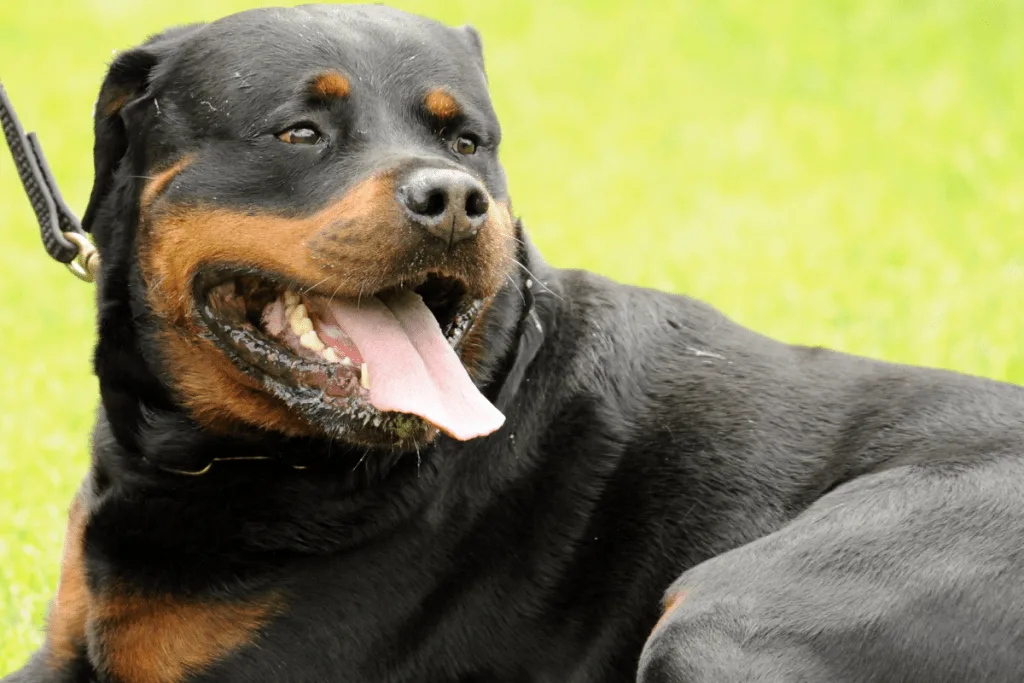
A purebred Rottweiler is double coated. If your Rottweiler lacks an undercoat, then they are likely not purebred.
A Purebred Rottweiler’s Outer Coat
The outer coat of a purebred Rottweiler should be of medium length, straight, coarse, and dense, and it should lie flat against the dog’s body.
Related: Your Rottweiler’s Coat: 8 Ways To Take Care Of It
It should be shortest over the Rottweiler’s head, ears, and neck, and it should be longest by the Rottweiler’s breeching, which is the upper and back region of the Rottweiler’s hind leg thighs.
The United Kingdom’s Kennel Club also mentions that the hair on the back of the forelegs can be a little longer, too.
However, there should be nothing that could be classified as feathering on a purebred Rottweiler.
If your Rottweiler has a long, wavy, or curly coat, then they are less likely to be a purebred Rottweiler.
Additionally, if they have a very short coat, like that of a Pit Bull, then they are more likely to have non-Rottweiler genes.
You do see long-haired Rottweilers, and some of these are even purebred Rottweilers and highly sought after. However, they cannot be registered with the AKC or the Kennel Club of the UK.
A Purebred Rottweiler’s Under Coat
A purebred Rottweiler will have an undercoat, but it will be shorter than the outer coat, so you cannot see it unless you part the hair of the outer coat.
The undercoat will be the thickest, mainly on the neck and thighs, but the undercoat will be thinner if the Rottweiler lives in a hot climate.
What Color Is a Purebred Rottweiler?
Purebred Rottweilers only have one color coat, and so any other color is a very good indication that your Rottweiler is a crossbreed.
A purebred Rottweiler will have a black coat with brown markings that can range slightly in color.
The AKC specifies the range as rust to mahogany.
There should be no marbling or roaning of the black coat and the brown markings; the distinction should be very clear.
As per the AKC, the brown markings should be found as follows:
- There should be one spot over each eye (it makes them look like they have really short eyebrows)
- There should be patches on both of the cheeks
- There should be a strip down each side of the Rottweiler’s muzzle (but nothing over the bridge of the muzzle)
- The brown markings should extend down to the throat
- There should be a triangle of brown on each side of the breast bone (prosternum)
- The lower half of the front legs should be brown—carpus to toes, but the toes should have black penciling
- Brown fur should line the inside of the rear legs, getting wider towards the toes but never eliminating the back from the pasterns
- The coat under the tail should also be brown
The undercoat can be black, gray, or tan, but, as mentioned before, you should not be able to see this through the outer coat.
Rottweilers that have white markings are possibly crossed with another dog breed, although this does not extend to the graying of an older Rottweiler. (Graying pertains to age, not breeding)
Spot a Purebred Rottweiler by the Way It Moves
Even though it sounds excessive, the breed standard even extends to the gait of a Rottweiler. This is probably because it is linked closely to the Rottweiler’s physical conformation.
So, how does a purebred Rottweiler move? They trot!
Your Rottweiler is not going to be an agile and spectacular sprinter, but trotting should look extremely natural to them.
The legs should not swing in or out, and the rear legs should basically follow in the prints of the front legs.
When a Rottweiler does run faster than a trot, its legs converge underneath it.
While moving, a Rottweiler’s back should remain straight.
The Temperament of a Purebred Rottweiler
Temperament is a less certain determiner of a purebred Rottweiler because it can be influenced or skewed by the Rottweiler’s experience, training, socialization, etc.
Furthermore, there are genetic anomalies, which lead to temperaments that deviate from the breed standard or which are even completely opposite to the typical Rottweiler temperament.
When Rottweilers with these genetic abnormalities in temperament are bred with, they can pass these on, creating a whole line of purebred Rottweilers with incorrect temperaments.
However, if your Rottweiler has a temperament that deviates or is contrary to the breed standard temperament, then they could be mixed with another breed.
According to the AKC, a purebred Rottweiler should be calm, confident, and courageous, with an aloofness that leads to reserved behavior around strangers.
In addition, they are self-assured and careful watchers of their environment, and they will act without causing a fuss.
Rottweilers should be very protective of their people and territory, and they are happy when working hard at a job.
A nervous Rottweiler and an aggressive Rottweiler do not conform to the breed standard and are more likely to be a mixed breed.
For a detailed look into Rottweiler temperament, be sure to watch the video below – it breaks the topic down in an in-depth, yet easy to understand way. Very useful information if you are considering getting a Rottweiler, or just want to understand yours better:
How Much Is a Purebred Rottweiler Worth?
Factors Affecting the Worth of a Rottweiler
The worth of a purebred Rottweiler is dependent on several factors.
A purebred Rottweiler that has a disqualifying or undesirable physical or temperament-related characteristic will be worth less than a purebred Rottweiler that matches the breed standard well.
A purebred Rottweiler that is registered with an organization like the AKC or the United Kingdom’s Kennel Club will be worth more than a Rottweiler which has equally high-quality characteristics but lacks official recognition from a registry body.
Rottweilers that have won recognized awards will be worth more than Rottweilers who have never competed or never won.
Additionally, the offspring of champion Rottweilers will be worth more than the offspring of registered, high-quality Rottweilers who have never competed or won awards.
An intact Rottweiler is worth more to some people than a sterilized Rottweiler. This usually pertains to those who wish to breed with the Rottweiler.
The same reasoning applies with regard to age. To those who wish to breed Rottweilers, a younger Rottweiler is worth more.
Male Rottweiler puppies tend to be worth less than female Rottweiler puppies.
What Is the Average Cost of a Rottweiler Puppy?
A registered purebred Rottweiler puppy can cost you anywhere between $1400 and $3500, with females costing a few hundred dollars more than males.
You can get a purebred Rottweiler for less from a non-registered breeder but choose the breeder carefully to ensure the health and pedigree of your puppy.
You can even get a purebred Rottweiler from a rescue shelter or organization, and this will cost you even less.
Final Thoughts
Unless a Rottweiler is clearly mixed with a different breed, it is difficult to tell if they are purebred or not.
Some of the most obvious signs will be a poorly muscled physique, blue, green, or bi-color eyes, and a coat that is not black with rust markings.
The breed standard is going to be your main source of comparison; if your Rottweiler clearly does not match, then it might not be a purebred Rottweiler.
However, you also have to remember that purebred Rottweilers can completely miss the breed standard due to bad genetics.
If you have paid for a purebred Rottweiler, you want to make sure that you get a purebred Rottweiler, but in the end, as long as your canine friend is healthy, even-tempered, and happy, who cares about pedigree!
